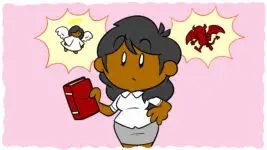J.R.R. Tolkien needs no introduction. One of the most famous British writers of the twentieth century, Tolkien is responsible for, among other things, giving the world hobbits, orcs, and one of Sean Bean’s more moving deaths.
Widely considered the greatest fantasy writer of all time, Tolkien’s masterworks – The Silmarillion, The Hobbit, and The Lord of the Rings – totally redefined the fantasy genre, and their influence has been humongous. There’s not a fantasy writer working today who hasn’t, in some way, had to navigate Tolkien’s gigantic shadow.
A philologist and linguist at Oxford University, Tolkien was able to pour his knowledge of European myths and language into Middle-earth, creating a living, breathing fantasy universe of frankly terrifying depth. He made up several Elvish languages (many with their own alphabets and distinct scripts), compiled social and cultural histories for each of his world’s factions and races, and drew up vast maps detailing every nook of his world. When it comes to world-building, there are few writers as thorough as Tolkien, but his work is also known for its epic, engaging plots and beloved characters.
Put together, it’s enough to make you ask what the patriarch of fantasy can teach writers, no matter what their genre. Let’s find out.
1. Let nothing stand in your way
Tolkien was a busy man. In between his university duties – ‘earning one’s living by teaching, delivering philological lectures, and daily attendance at “boards” and other talk-meetings’ – illness, non-university work, and missing his son, Tolkien would pursue his ‘serious work’: writing. Many of us put off writing, waiting forever for the perfect time, but Tolkien knew that there was no such thing – there’ll always be other things in the way.
Tolkien’s grit reminds me of Toni Morrison, who famously woke up at silly o’clock in the morning to write before she had to take her kids to school, and John Steinbeck, who laboriously forced himself to write each day, even though he thought a lot of what he was writing was bad. Churning out great novels, it turns out, is a matter of putting the hours in, not strange fits of passion.
Beyond the minutiae of life’s trenches, writers are often stopped by self-doubt and its odd bedfellow, grandiosity. Tolkien had no time for that. He was always humble about his work, meaning he was able to approach it without worrying that a bad paragraph would mean the end of the world, and his self-doubt was productive; when he read back his work and found something he didn’t like, he didn’t despair and give up – he picked up his pen and tried again until it was better. This kind of grounded, non-pretentious approach to work is a rare thing, and it’s something we should all aim for!
2. Share and listen
Tolkien’s humble, balanced attitude regarding his own work was also expressed through his eagerness to seek out peers willing to read his work and to actively listen to them when they criticized it.
Tolkien was part of an Oxford-based writing group called The Inklings alongside several other writers, chief among them C.S. Lewis, author of The Chronicles of Narnia, and it was they who were exposed to the early drafts of Tolkien’s writing. Lewis in particular was instrumental in the development and eventual publication of The Lord of the Rings; when Tolkien had grown disillusioned with several early drafts and was just about ready to give up, it was Lewis who encouraged him to continue. Tolkien would later claim that Lewis ‘was for long my only audience… Only from him did I ever get the idea that my “stuff” could be more than a private hobby.’ This encouragement would continue throughout the slow growth of The Lord of the Rings:
When he would say, ‘You can do better than that. Better, Tolkien, please!’ I would try. I’d sit down and write the section over and over. That happened with the scene I think is the best in the book, the confrontation between Gandalf and his rival wizard, Saruman, in the ravaged city of Isengard.
– J.R.R. Tolkien, The Collected Letters of J.R.R. Tolkien
The takeaway here is simple: seek out criticism, listen to your critics, and rework with those criticisms in mind. After all, it worked for Tolkien!
3. Chase your interests
‘Write what you know,’ goes the old writer’s adage, but Tolkien twists it a little: knowledge is fine, but really, he says, you should write what you like. You might know a lot about filling in tax returns, but that doesn’t necessarily make for a great story.
Instead, pick something you enjoy – something you’re passionate about. After all, novels are long old things, and you don’t want to be 30,000 words into a manuscript only to realize that, actually, you couldn’t care less about your subject.
Tolkien’s own interests were language, fairy tales, myths, and fables – and, as a result, The Hobbit and The Lord of the Rings were born. What if he’d tried to write about, say, birds or carpentry?
4. Find characters in the real world
Writers have always found inspiration in the real world; Virginia Woolf writes wonderfully, in ‘Mr. Bennet and Mrs. Brown,’ about watching a couple on a train and explains the process of turning them into characters, and more recently American writer David Foster Wallace described writers of fiction as ‘born oglers.’ Tolkien finds himself in firm agreement; like these other authors, he too found direct inspiration in the people around him.
There was a curious local character, an old man who used to go about sweeping gossip and weather-wisdom and such like. To amuse my boys I named him Gaffer Gamgee, and the name became part of family lore to fix on old chaps of the kind. At that time I was beginning on The Hobbit. The choice of Gamgee was primarily directed by alliteration; but I did not invent it. It was caught out of childhood memory, as a comic word or name. It was in fact the name when I was small (in Birmingham) for ‘cotton-wool.’
– J.R.R. Tolkien, The Collected Letters of J.R.R. Tolkien
The Gamgees, the most famous being Samwise, are of course the salt-of-the-earth farmer types built, let’s be honest, on stereotypes of rural folk from the English South-West. You have to wonder where else Tolkien found character templates – did Gandalf begin life as a venerable old Oxford professor? Was Saruman an imperious rival? Was Smaug a particularly tyrannical dog?
Regardless, the important thing is to pay attention to the people you encounter and to allow your imagination to run away with itself. Yes, maybe the man who came to fix your fridge was just crabby because he was up at 5am, or maybe he was crabby because his villainous delusions of grandeur tell him that tending to fridges is beneath him – with his towering skills, he should be ruling this city!
5. Understand market demands (or trust those who do)
Yes, Tolkien may have produced some of the most important works of fantasy fiction ever, but that didn’t mean he knew anything about how it should be published, marketed, and sold. After Sir Stanley Unwin paid his ten-year-old son a shilling to go through the manuscript of The Hobbit, only deciding to publish it after the boy wrote and submitted a glowing report, he went back to Tolkien to commission a sequel, the book that would become The Lord of the Rings.
By the time Tolkien had finished his monstrous 600,000-word first draft, he was exhausted and confused about what he’d just produced:
And now I look at it, the magnitude of the disaster is apparent to me. My work has escaped my control, and I have produced a monster: an immensely long, complex, rather bitter, and very terrifying romance, quite unfit for children (if fit for anybody); and it is not really a sequel to The Hobbit but to The Silmarillion.
– J.R.R. Tolkien, The Collected Letters of J.R.R. Tolkien
Despite this reaction and his admission that he could ‘see clearly how impractical this is,’ Tolkien resisted Unwin’s suggestion to break the mammoth book down into three to five smaller volumes. Instead, he insisted not only that The Lord of the Rings be published as one big book, but that The Silmarillion should be added in too, creating an obscenely large book that would have sold maybe three copies to curious masochists.
Thankfully, Unwin successfully talked Tolkien out of this by explaining that he, as a publisher, had to actually sell the books he printed and that no one in their right mind would pick up a book they couldn’t physically carry. And so The Fellowship of the Ring, The Two Towers, and The Return of the King were born.
It just goes to show that though authors know their own work and the vision they’re trying to substantiate, they often have no idea how to best ensure their creation reaches the most people. The lesson is this: don’t allow your ego to dictate publishing and marketing plans that won’t actually benefit your work; ask someone who knows the business!
6. Don’t just write
When it came to planning, few writers were as terrifyingly thorough as Tolkien. The man didn’t just produce plot and chapter summaries, didn’t just list his cities and nations – he did everything. He wrote the folk songs and epic poems of Middle-earth’s peoples; he drew sprawling maps covering the entire surface of his huge world; he dreamed up myths, legends, and histories; he drew crude pictures (Tolkien may have been a good writer, but he was not a talented artist) depicting relics, characters, cities, and weapons; he produced new alphabets and languages and political systems.
With a world this wide, deep, and populated, Tolkien’s storylines basically sprung up organically and wrote themselves. While he planned his plots, he was continually taken aback by how storylines would branch and dynamics develop seemingly on their own, all due to the richness of his world and the thoroughness of his planning.
There and back again
So there we have it: six lessons from the king of fantasy. I don’t know about you, but several of Tolkien’s tips took me by surprise – I wasn’t expecting him to be so humble and grounded, so receptive to the ideas and support of others. It suddenly makes more sense that his most famous novels concern protagonists who only succeed in their quests because of the support and sacrifices of their allies.
So, next time you’re planning a story, whether it’s fantasy or not, maybe take a leaf out of Tolkien’s book (he’s got plenty, after all!) and map out your world, its factions, its characters, its history, its politics, its languages, the songs and stories its peoples repeat… get as much as you can down before starting on the story proper and, once you do begin, keep checking in with a reliable friend, critic, or editor. And, though the work may be tough, allow your interest and passion to carry you all the way up to Mount Doom (even if you have to lean on Sam while you climb).
Which is your favorite of J.R.R. Tolkien’s novels? What lessons did you personally glean from his work? Let me know in the comments, and check out 12 Ways Neil Gaiman Can Help You Improve Your Writing Right Now and 7 Ways Kazuo Ishiguro Can Help You Improve Your Writing for more advice from literary greats.






1 thought on “6 Ways J.R.R. Tolkien Can Help You Improve Your Writing”
Thank you, Mr. Johnson, for this enlightening article. I only take issue with your comment that Tolkien “was not a talented artist.” Although Tolkien himself disparaged his talent, I believe the original cover of “The Hobbit” speaks for itself. I suggest your readers take a look at one of the several books that have been published about his art. My favorite is “Tolkien: Maker of Middle Earth,” by Catherine McIlwaine.